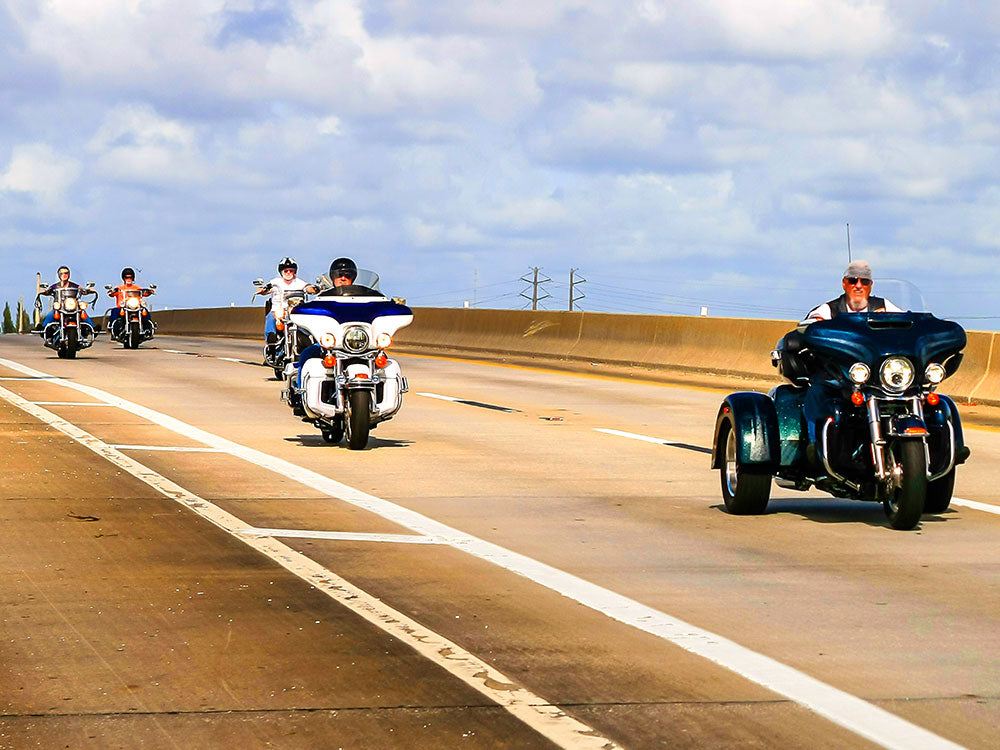Table of Content
Certainly, Florida is blessed with great ocean views and hidden gems prevail to get explored. It is the home of a large number of motorcyclists, who adore discovering intriguing sights and fantastic riding weather.
Riders intersect in the Sunshine State for major events, like Daytona Bike Week and Biketoberfest. Thousands of Florida locals anticipate their motorcycles for daily commutes. To ensure compliance and safety it is crucial to know Florida's, Motorcycle Laws.
1. Motorcycle Rules and Regulations in Florida, USA
1.1 Motorcycle Gear Laws for Riders
Helmet Law
In Florida, a rider must wear a helmet every time they are riding a motorcycle if he or she is under the age of 21.
According to section 316.211(3b) subsection 1: All riders, over the age of 21 may choose not to wear a helmet while operating a motorcycle. He or she must have at least a $10,000 insurance policy providing benefits for injuries as a result of a crash.
Headset Law
In obedience to section 316.304(1): It is restricted to all motorcycle riders not to wear any headphones, headset, or any other type of listening device while operating a motorcycle.
Only persons having hearing problems are allowed to use a hearing aid or instrument for the improvement of defective hearing.
Eyes Protection Law
Yes, wearing eye-protection instruments is always required while operating a motorcycle. Following section 316.211(2): A person may not be allowed to operate a motorcycle unless he or she is not wearing eye-protection gear that is approved by the department.
2. Motorcycle Equipment Requirements
2.1 Front and Back Brakes
Yes, all vehicles must be equipped with front and back brakes. According to section 316.261(3): All motor vehicles, bikes, cars, trailers, semi-trailers, and pole trailers, operating upon a highway within Florida shall be equipped with brakes.
2.2 Motorcycle Exhaust Law
Yes, there is a motorcycle exhaust law that exists for motorcycle riders. According to the following section 316.293(5)(b): modification of the exhaust pipes is restricted and no person may be allowed to operate his or her motorcycle on the state’s highway with the modified exhaust system or noise-abatement device.
Furthermore, following section 316.272(2): The engine and power mechanism of the motorcycle should be equipped and adjusted perfectly to prevent smoke and excessive fumes.
2.3 Handlebar Height
According to the Florida Motorcycle State Law, the height of the motorcycle handlebar should not be exceeded to the rider’s shoulders.
In section 316.2095(2) it is stated that: No rider shall operate any motorcycle with handlebars that are higher than his shoulders while properly seated upon the motorcycle.
2.4 Motorcycle Horn Requirements
Yes, a horn is required. In alliance with section 316.271(1): motorcycles when operated upon a highway shall be equipped with a horn in good working condition and can be audible from a distance of fewer than 200 feet.
2.5 Motorcycle Mirrors
No matter if a motorcycle vehicle is operating upon a highway or towing by another vehicle a motorcycle must have rearview mirrors.
2.6 Headlights
According to section 316.405: Is required to use daytime headlights for all the motorcycle riders in Florida. It is compulsory to keep your motorcycle headlights on even if a rider is operating his motorcycle in the daytime.
In section 316.400(1) stated: Every motorcycle or every motor vehicle shall be equipped with at least one or two headlamps. But there is a restriction on installing more than two headlamps.
2.7 Stop Lamp and Rear Red Reflector Requirements
Section 316.234(1) stated: All the motorcycles and motor-driven cycles must have at least one stop lamp.
Furthermore, all the motorcycles must have at least one rear red reflector either attached separately or with the tail lamp, as stated in section 316.415.
The violation of these sections is a noncriminal offense yet punishable as a nonmoving violation.
2.8 Turn Signals
Yes, turn signals are required. In section 316.222(2) it is stated that: Every motorcycle shall be equipped with electric turn signals.
2.9 Tail Light
According to section 316.410(1): Every motorcycle must have at least one tail lamp which shall be located at the height of not less than 20 inches nor more than 72 inches.
3. Florida Motorcycle Riding Laws
3.1 Lane Splitting
According to Florida Motorcycle State Law, lane splitting is not legal. It is prohibited for motorcyclists to overtake and pass in the same lane occupied by the other vehicles.
3.2 Riding Two Abreast
Florida Motorcycle State Law allows the riders to ride two abreast. Other vehicles are required to give riders a full lane.
3.3 Speed Competition, Drag Racing on Roadways or Parking Lots
In section 316.191(2)(a): No rider is allowed to drive any type of vehicle or motorcycle, in any speed competition, drag racing, and acceleration contest to set a record on any parking lot, highway, and roadway.
3.4 Is Carrying Item(s) Allowed?
No motorcyclist is allowed to operate a motorcycle while carrying items or any type of package, which prevents him or her from keeping both hands on the handlebar.
4. Passenger Laws in Florida
4.1 Passenger Seat Requirements
If you are riding two persons on a motorcycle, it is required to have a passenger seat or a seat for two. According to section 316.2085(1): The rider must get a seat attached for the passenger permanently if they ride often along.
4.2 Does the Passenger Need Footrests?
Yes, the passenger footrests are required. According to section 316.2095(1): All motorcycles must contain passenger footrests unless they have a sidecar or enclosed cab connected.
5. Motorcycle Endorsement Laws
5.1 Motorcycle Endorsement Requirements
Yes, motorcycle endorsement is required in Florida. According to section 322.03(4): It is prohibited for a motorcycle rider not to operate a motorcycle unless they have a license that authorizes appropriate endorsements and restrictions.
However, a person is allowed to operate an autocycle, without a motorcycle endorsement.
5.2 Three-Wheeled Motorcycle Restrictions
Dealing with the licensee’s driving abilities with respect, special mechanical control devices shall be required on a motorcycle (three-wheeled) that they may easily operate.
6. Required Tags
6.1 Exterior Rear Tag Requirement
Under section 316.605(1): All motorcycles must be licensed in the name of the owner whether they are riding, parked on the roads, highways, and streets.
6.2 The tag must be Permanently Attached
The license must be permanently attached to the motorcycle and can be easily seen from the rear all the time. Any deliberate act to conceal and obscure the legibility of the license tag of the motorcycle is prohibited.
Moreover, the license tag of the motorcycle should be affixed horizontally to the ground so that the numbers and letters can be easily read from the left or right sides.
6.3 Tag Light Required-White
To make sure the visibility of the registration plate, a white light whether attached separately or integrated into the tail lamp, must be installed on the motorcycle.












Leave a comment
All comments are moderated before being published.
This site is protected by hCaptcha and the hCaptcha Privacy Policy and Terms of Service apply.